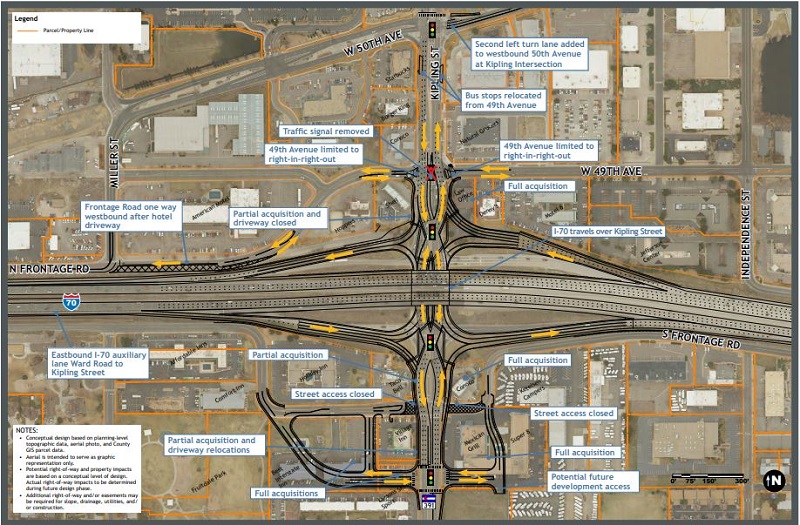“Diverging diamond” interchanges, such as the one proposed for I-70 at Kipling Street in Wheat Ridge, have been shown to reduce all car accidents by 46 percent.
Innovative Intersection Planned for Wheat Ridge
True innovation comes in unexpected shapes. For motorists in the greater Denver area, that shape will come in the form of a “diverging diamond”, a highway interchange configuration designed to reduce congestion and serious car accidents in Colorado.
The Colorado Department of Transportation (CDOT) is planning one of the recently developed traffic configurations for the famously congested intersection of Interstate 70 and Kipling Street in Wheat Ridge, where close to 200,000 motor vehicles pass every day, The Denver Post’s John Aguilar reported. CDOT recently held a public comment meeting in the Wheat Ridge community. While the broad strokes have been drawn, the ambitious project hasn’t yet been given a timeline or a rough budget. The agency gives additional details on its website.
The strange-looking twists of traffic ramps are gaining popularity as a way to efficiently move massive amounts of traffic through problem intersections. Colorado already has three of the configurations, in Colorado Springs, Grand Junction, and Superior-Louisville. Three more are in the planning stages.
A Strange, New, and Efficient Idea
The idea of diverging diamond intersections is still in its infancy based on general public works project standards and guidelines. The first one was built in Missouri only in 2009, however, there are already dozens more across the United States. The concept calls for sending traffic over or under a large highway by using a crossover pattern. The crossovers route vehicles to the left side of the road as they pass through the intersection and then back to the right side. As odd as it sounds and looks, the design eliminates left turns that conflict with oncoming traffic, a problem that can halt traffic through several stop-light signals and cause serious crashes.
The Federal Highway Administration (FHA) calls the new configurations “an innovative, proven solution for improving safety and mobility at interchanges.” The agency says they can cut “vehicle-to-vehicle conflict points” by fifty percent and reduce all crashes there by 46 percent.
Although they look strange at first, the designs are “intuitive” for drivers at the wheel, the federal agency says. The roads’ geometry, signs, and pavement markings make driving through them so simple that drivers in cities where the crossover intersections have been built say they don’t even notice them. The new intersections can save state and local road-building agencies more than 75 percent over other styles of intersection improvements because they stay within the footprint of the existing intersection.
FHA says the improved intersections just perform better than the former configurations. They:
- Reduce delays by 15 percent to 60 percent
- Increase traffic flow by 10 percent to 30 percent
- Eliminated left-turn crashes where they were built
- Reduced right-angle crashes by 72 percent
- Reduced rear-end accidents by 29 percent.
A recent study by INRIX Research that says Denver-area drivers lost a cumulative 83 hours to traffic congestion in 2018.
In the first year since Superior’s diverging diamond intersection was completed, the town reported no injury crashes and saw a 36 percent reduction in non-injury crashes, the newspaper report says.
Patrick Goff, Wheat Ridge city manager, told The Post he doesn’t worry about drivers getting confused by the reworked I-70 and Kipling Street exchange. The original design originated in the 1960s and needs significant improvement because it forces drivers to wait through multiple traffic signals while drivers ahead wait to turn left.
“This design may take a bit to get used to by drivers,” Goff said, “but with proper signage and road markings the interchange is actually fairly easy to navigate.”

